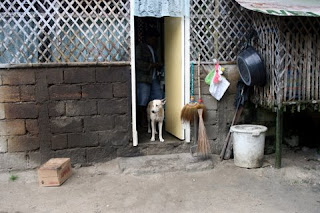
A typical Filipino back door.
Once, in Paris, a friend's Basque mom excitedly showed me a broom she had bought in the Philippines. After criticizing all other incarnations of escobas and praising the beauty of the soft walis tambo (and stroking it quite lovingly), she set it back up for display. At that moment I decided I was probably taking these things for granted.
While the fanned out tambo, made of dried native tiger grass, sweeps dirt up better than any plastic implement, over time it sheds its long stalks (though "first class" walis will tend to hold this off for sometime) and you end up sweeping parts of it up as well. A balding one is left with short hairs, but is then superb for dusting out the corners of your ceilings or cabinets.

Walis tambo hanging, and a walis tingting by the dustpan.
The walis tingting is made by gathering the thin sticks at the center of coconut leaves and tying them together. I remember our household helper teaching me how to make one when I was little, brandishing a knife and expertly separating the leaf part and discarding it. The tingting (which literally means something like "thin stick") makes a nice whipping sound when you wave it around in the air.
Our walis is ingenious and beautiful. They are made of quickly renewable, widely available material and goes back into the earth after its useful life. Being a tropical country that is exploding with life and quick decomposition, our tools and housing have always gone through the same relatively short cycles. Nonetheless, relative abundance should make it inexpensive to create replacements. If we want to live effective lives, we need to put importance on biodiversity and encouraging fecundity.





